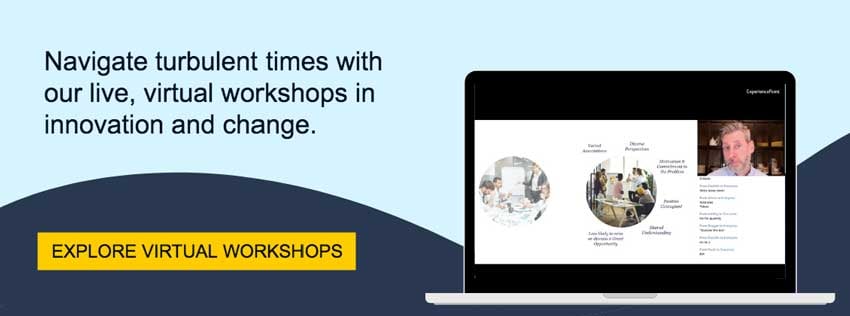Though this time of global change and of mass digital transfomation, we have seen the habits and rhythms of our workforces, leaders and consumers shift, along with their individual perceptions of what could and couldn’t be possible in this new reality.
Within the realm of innovation and design, perceptions around collaboration have been particularly challenged against the long-standing belief that the best things happen when people work directly together in one physical space.
From our distanced workspaces we begin to ask ourselves: How do we keep innovation alive when we’re far apart? How do we collaborate when in-person innovation labs and Post-it filled meeting rooms are not an immediate possibility?
If we begin with the fundamentals of human-centered thinking — we are reminded that every challenge and change comes with great possibility, rather than limitations. Using this mindset, we can be certain that achieving innovation results virtually is not only possible, but that virtual collaboration can unlock even greater results than its traditional practice.
Let’s review a few of the immediate positives:
-
Virtual collaboration opens up the possibilities for more diverse perspectives, as designers are not inhibited by the geographical limitations of bringing diverse groups of people together.
-
When you put people together in a room, instant barriers are formed. Being social, creatures, distractions are bound to occur. Virtual collaboration allows for a more structured setting in which teamwork and natural socialization are not so readily confused.
-
We are all aware that the virtual world has allowed for people to be bolder with their thoughts and feelings. Where we are quick to perceive this in the negative, that freedom of expression can bode well for collaborators, allowing them to more easily share wild ideas, where person-to-person interactions can lead to an amplified fear of judgment and mockery.
-
Collaborations within a virtual context will mean that innovators are creating and solving issues for the immediate needs of today’s immense and growing virtual community while being part of that virtual community themselves— allowing them to readily empathize with their customer’s challenges and needs firsthand and to dynamically innovate for a virtual world.
As we work towards a new definition of collaboration with these important opportunities in mind, let’s consider the very nature of the word. Collaboration, as defined in the Oxford English Dictionary, is “ the act of working with another person or group of people to create or produce something.” Nowhere here, or in any other definition found, does it state that these interactions must be carried out in-person.
Just as we can use our innovative minds to iterate on this long-held notion that in-person necessitates innovation, so too can we upend the common perception that successful human-centered design requires in-person circumstances. In fact, human-centered design as a philosophy leverages myriad tactics to aid in problem-solving and much like the people who leverage its principles, can evolve and change where needed.
With that in mind, and with so many virtual platforms available to allow for remarkable collaboration in a virtual space such as MURAL, Jamboard and Sprintbase, we can be confident that human-centered design is thriving in our new reality, empowering innovators with a structured and scalable process that will continue to allow anyone in any circumstance to collaborate, innovate and drive impact through challenging times and beyond.
